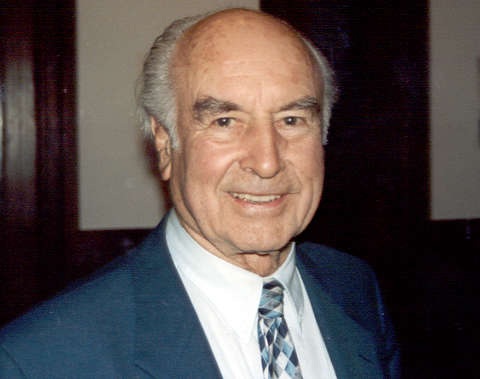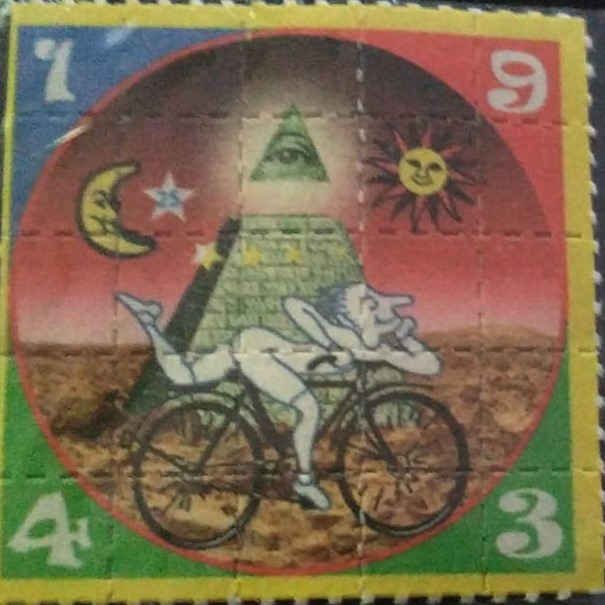
Albert Hofmann (1906-2008), photo: Philip H. Bailey (E-mail), CC BY-SA 2.5, via Wikimedia Commons
On April 19, 1943, Swiss chemist Albert Hofmann in the Sandoz (now Novartis) laboratories in Basel, Switzerland performed a self-experiment to determine the true effects of LSD, intentionally ingesting 0.25 milligrams (250 micrograms) of the substance, an amount he predicted to be a threshold dose (an actual threshold dose is 20 micrograms). While riding home on his bicycle, he experienced the very first LSD trip, now referred to as “Bicycle Day”, and proved that he had indeed made a significant discovery.
“It is a widespread opinion that the objective, material world view of the natural sciences and the mystical-religious world experience contradict each other. The opposite is true. They complement each other to form a comprehensive insight into one and the same spiritual-material reality.”
– Albert Hofmann: in Praise of Looking, 2002
Albert Hofmann investigating Lyseric Acid Derivatives
Albert Hofmann was born in Baden, Switzerland and studied chemistry at the age of 20 with major interests in plants and animals. Later on, Hofmann researched on chemical structures of chitin, which he received his doctorate degree for. When Albert Hofmann joined the pharmaceutical-chemical department of Sandoz in Basel, he studied the plant squill and the fungus ergot in order to purify and synthesize their components and use them as pharmaceuticals. On November 16, 1938, Hofmann intended to obtain a respiratory and circulatory stimulant when researching lysergic acid derivatives. This was the day, the scientist first synthesized LSD, but he decided to set aside this subject for a while. In animal experiments, the substance caused unrest among the animals, but showed no usable or pharmacologically interesting properties and was therefore not investigated further.
However, in 1943 Hofmann decided to produce LSD again. During the laboratory work, sudden restlessness and discomfort caused him to stop working and go home. Arriving home with his eyes closed, he had intense kaleidoscope-like, colorful visions for about two hours. Probably he had accidentally and unexplainedly picked up a trace of LSD. In his book “LSD – Mein Sorgenkind” (LSD – My problem child) Albert Hofmann states that he may have accidentally picked up the LSD through his fingertips.

25 LSD blotters Printed Image: 1943 Bicycle day, photo: DarkGreyCat, CC BY-SA 4.0, via Wikimedia Commons
A Dangerous Self Test
Surprised by the effects of the substance, Hofmann decided to perform a self-experiment on April 19, 1943. He ingested himself 250 micrograms of LSD, thinking of it to be a threshold dose which is actually 20 micrograms. Hofmann noted to feel the effects of the drug about an hour later. His assistant was to escort Hofmann home, but since due to wartime restrictions cars were prohibited, they had to take the bike. On his way home he struggled periods of anxiety and thought of his neighbor to be an evil witch. He called for a doctor, who could not detect any physical abnormalities except for extremely dilated pupils. Later on, Hofmann noted about his feelings that
“… little by little I could begin to enjoy the unprecedented colors and plays of shapes that persisted behind my closed eyes. Kaleidoscopic, fantastic images surged in on me, alternating, variegated, opening and then closing themselves in circles and spirals, exploding in colored fountains, rearranging and hybridizing themselves in constant flux”
The ergot, whose negative effect was already known as “holy fire” in the Middle Ages, continued to be researched medically, as its ingredients include a substance that acts on muscle tone, which can be used, for example, in pregnant women to induce labour. The name ergot derives from this effect on the uterus, which has been known since the Middle Ages.
Bicycle Day
Done with his experiment that later became widely known as ‘Bicycle Day’, Hofmann knew he had discovered an incredible psychoactive substance if used in lower doses. And indeed through the 1950’s, the drug received much research attention and every undergraduate psychology student took LSD as part of their education. Most medical institutions began using the substance in order to research on its ability to cure like alcoholism or to enhance creativity, like Sidney Cohen did with the help of Aldous Huxley.[5] Through the years hundreds of scientific papers and numerous books were published on the effects of the substance on the human body in the medical sense. And indeed it was successfully applied on several mental illnesses. But in the 1960’s, it was found that LSD had a high potential in abuse and was made illegal in most western states.
Hofman’s Further Achievements
Hofmann’s much acclaimed dissertation (1929) focused on the structural elucidation of chitin. As a research chemist at Sandoz, he developed the first precisely dosed heart medication from digitalis glycosides, later the geriatric drug Hydergin, the circulatory agent Dihydergot and Methergin, which is still used today as the standard medication in gynaecology, before turning to research into ergot. His publications include over 140 scientific papers and numerous books.
Timothy Leary – From Research to LSD Parties
One of the most prominent LSD researcher was probably Dr. Timothy Leary, who began focusing his work on the substance while teaching at Harvard University. But after a while, student’s parents as well as university officials began criticizing Leary’s methods wherefore he was expelled from the institution. However, he kept researching up to a point where he was not able (or maybe did not want) to control his experiments anymore. His meetings turned into LSD parties and were monitored by the CIA. Richard Nixon then described Leary as the “most dangerous man in America“.
Hofmann’s Potion, Connie Littlefield, provided by the National Film Board of Canada [7]
References and Further Reading:
- [1] Hofmann’s Potion, a documentary on the origins of LSD
- [2] Albert Hofmann: LSD, My Problem Child
- [3] The Albert Hofmann Foundation
- [4] Inside LSD – National Geographic
- [5] The Visionary Dystopies of Aldous Huxley, SciHi Blog
- [6] Albert Hofmann at Wikidata
- [7] Hofmann’s Potion, Connie Littlefield, provided by the National Film Board of Canada
- [8] “Obituary: Albert Hofmann, LSD inventor”. Daily Telegraph. London. 29 April 2008.
- [9] Hofman, Albert; J. Ott (1996). “LSD: Completely Personal”. Newsletter of the Multidisciplinary Association for Psychedelic Studies. 6 (3).
- [10] Albert Hofmann, “LSD, My Problem Child”. psychedelic-library.org.
- [11] Horowitz, Michael. “Interview with Albert Hofmann”, High Times (1976)
- [12] Timeline of Psychedelic Drug Researchers, via DBpedia and Wikidata






Pingback: Whewell’s Gazette: Year 2, Vol. #37 | Whewell's Ghost